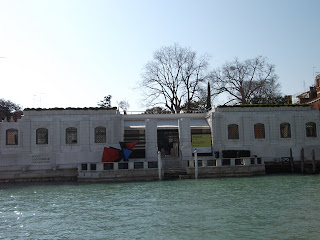Our last day in Opatija was spent in a by now familiar manner. Leisurely breakfast consisting of yoghurt and fruit, a cappuccino and brioche a little later, then a 40 minute walk to Volvosko for a fine lunch at one of the fish restaurants. A cold octopus salad for Mary Jo and a seafood pasta for me, preceded by a clear fish soup with some quinoa, and followed by some cheese. Then a walk back, a nap, packing, and a light snack.
Sunday we were up at 5AM, walked to the bus station for the 6:20 bus to Trieste. There was a 40 minute wait at the Croatia - Slovenia border for no apparent reason. Then the train to Venezia-Santa Lucia station and a vaporetto to the Lido stop. The hotel is at Piazza Santa Marie Elisabetta, which is also just at the vaporetto stop. There is a pleasant feel to the neighborhood. Children going to and from school, commuters going to and from work. I understand that Venice is largely an artificial city that subsists on tourism. Perhaps the Lido is more than this.
Our room is adequate. There is a charge for internet service, which makes a change in our habits. We are now reading a paper copy of the IHT, as in the old days.
There is a unity of design in this trip that is pleasant to contemplate. Trieste in the upper east side of the Adriatic, then a little south to Opatija, then north and over to the Lido on the northwest side of the Adriatic, then next week to Venice proper. Always with a view of the Adriatic Sea.
In the morning we took a 2 hour walk south of the vaporetto stop and back. Nice houses or apartments, a neighborhood feel. There are many small canals that go in from the lagoon but do not go all the way over to the Adriatic side. The island is a long sandy spit of land. We walked back along the Adriatic, noting the beach cabanas. There used to be several grand hotels along the beach, one of which is feathered in Thomas Mann's novella "Death in Venice". Ten years ago, we stopped with Carolyn at this hotel for a coffee. Now the hotel has vanished, an appropriate end to the decay and death which the story commemorates.
In the late afternoon we went out again and as a lark took a bus at random from the Santa Marie Elisabetta piazza. The bus went down to the south end of the Lido, and then got on a ferry crossing to another island, with a full load of passengers. As the trip continued and it started to get dark, we asked ourselves, might this be the last trip of the day? Near the end passengers started to disembark, and at the end Mary Jo asked about the return, and there was no problem. The trip was along a rather narrow stretch of land with a high dike on the sea side and low flats on the lagoon side. It seemed to me that there were fish farms and perhaps other industrial activity there, as well as some small towns. I suspect we were also not far from the major industrial area (chemicals, petroleum) of Marghera. By the way, I can attest to Mary Jo's verbal skills in Italian.
Tuesday, a chilly clear day, we went to Torcello to see the mosaics there. This involved 3 boats but worked out well once we mastered the system of boats, more complicated than a subway system. These mosaics were done in the 11th century, are in very good condition, and are lovelier than I had remembered from the first time we saw them. Dinner involved Scotch eggs, which in this case means 3 egg yolks, soft boiled and then breaded (unless the process is the reverse), and then served over some spinach.
Went to Venice proper on Wednesday, walked around a lot, got lost, then came back and went to an Indian restaurant for supper.
Thursday we packed and took the vaporetto to our last stop in Italy. The hotel is near the train station and not large but pleasant. A good view of the canal overlooking the station, and the breakfast (I am writing this on Friday) is not too bad. Internet is not as good as in Croatia but not bad.
The trip down the Grand Canal to the hotel is surely one of the fine sights in the world. There will be a few pictures that will not do it justice. This trip was also enlivened by a phone call received by the woman on the seat behind us. Clear reception, distinctive American accent, somewhat loud voice. The gist of the conversation seemed to be that she wants an immediate separation, does not want to continue living in the same house. They have been married 25 years and she can not face the prospect of another 25 years with him. There is no one else, but she does not rule out the possibility. Repeated several times with more emphasis. Then, conversation broken off and she left at the next spot. I did not have the wit to stand up and applaud.
The first 2 pictures are of the entrance to the Grand Canal.
Now we see the Peggy Guggenheim Museum, a place we like to visit.
The next 7 pictures are just of scenes taken while traveling down the Grand Canal.
Here we have a shot of Fr. Paolo Sarpi, who in the 1500s argued against the pope and for the independence of Venice.






























